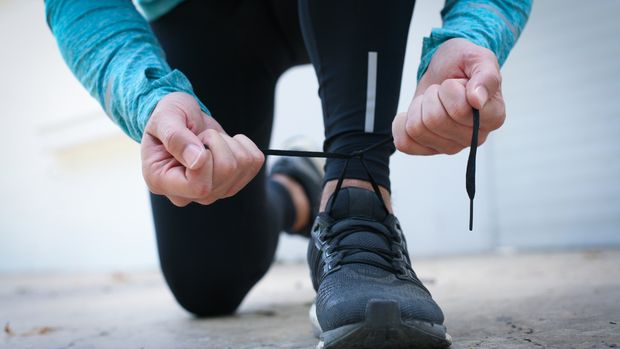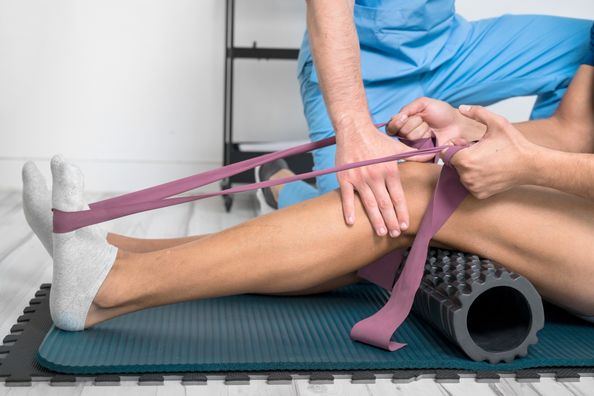This article was originally published in Race Play Michiana June-July 2016
As your training efforts work toward meeting upcoming goals, take an honest self-assessment of strengths, weaknesses, and past performances. With increased demands on your body, you may begin to notice weak areas in your feet, ankles, knees, legs, hips, and/or back that are triggered by increased mileage, speed, or aerobic impact. Remarkably, on long runs, I’ve even encountered neck and shoulder pain. Too often, the culprit to these aches and pains is poor alignment from the lower extremities. Fortunately, there are products — or modalities — available that will relieve your pain and keep you running without further chronic injury.
The art of the step: Proper Biomechanics
Much happens when you take a step. During roughly 60 percent of your time walking or running, your body’s mass resides on one foot. Depending on your speed, this can translate three to nine times your body weight on each lower extremity with each step. At heel strike, your foot should contact the ground just lateral to the center of your heel. As your body moves forward, your slightly supinated (rolled outward) foot will pronate (roll inward) to accommodate the surface on which you’re waking and serve to absorb shock. Just before heel left and toe push-off, your foot will re-supinate, locking it into a rigid lever to propel you forward.
Where things go wrong
In the pronation phase, if you hyper-pronate (roll inward too much), your tibia rotates inward, taking along your hip as it goes. In this situation, your foot cannot properly re-supinate to gain a proper mechanical advantage in propulsion. Repercussions can be let in the feet, ankles, shins, knees, hips, and back. Likewise, if you over-supinate, you cannot accommodate proper shock absorption and are more vulnerable to lateral stress fractures in the feet, ankle sprains, and excessive compression in the knees, hips, and back.
Know your support systems
Each in their way, orthotics and arch supports are designed to support and correct the feet during the stance phase of gait. While both are intended to replace the insoles in your shoes and support your feet, an orthotic is custom-made for you. Once acquired, orthotics should be used in each shoe for at least 85% of your overall activity. Your body will adjust to the new corrected alignment, but intermittent use — such as wearing them only when you run – will perpetuate localized irritation and discomfort, much like intermittent use of reading glasses. There are two kinds of orthotics: functional and accommodative orthoses.
Functional Orthotics are designed to correct malalignment and can influence your body all the way through your hips and spine. They keep your rearfoot in its neutral position and coordinate this alignment with your forefoot and lower extremity so your stride stays within the normal parameters of motion. This will de-rotate your tibias, align your knees, and reduce the abnormal tension in your hips and lower back. Functional orthotics are typically made by casting a 3‑D replica of your feet while the foot is held in its corrected position. This is usually done with plater or in foam. Once in use, functional orthotics can help an athlete perform at maximum potential longer, without fatigue. They can also help everyone ambulate longer, more comfortably and reduce the harmful sequela associated with malalignment such as bunions, hammertoes, neuromas, plantar fasciitis, etc.
Accommodative Orthotics support your feet in their current position. These are often made by standing on a mechanical device or walking across a plate. Accommodative or “soft” orthotics offload prominences and offer support in an inflexible foot. In less active individuals, they accommodate biomechanical dysfunction and seek to relieve pain. These are outstanding older patients, those with limited mobility or feet that have very minimal biomechanical dysfunction. These are typically not used in athletes or individuals with jobs that require extensive weight bearing.
Arch Supports are simply what the name implies. They add a little extra support in a shoe to allow better function in higher-stress situations. People with minimal discomfort or biomechanical irregularities can benefit from these over-the-counter devices. Typically, people who see an initial benefit from arch supports but need more support later will usually do quite well with custom orthotics. While I don’t favor any particular brand of OTC devices, I’ve seen many quality arch supports coming from local shoe retail stores. Look for a firm device (to control motion), combined with a soft pliable top-cover to provide cushion from impact.
Other over-the-counter options
Metatarsal pads are to be worn under the forefoot just behind the metatarsal heads. They not only offload the metatarsal heads from impact but also functionally spread them, relieving painful compression against a developing neuroma. Be careful to place them properly in the shoes and not too far forward to be prominent against the metatarsal heads.
Toe caps or gel sleeves are devices that may be beneficial for an area of your toes that is subject to chronic pressure. They can be used to protect a vulnerable toenail, a toe in malposition, or an area of friction between two toes.
Two Day Rule
Take two days off if a body part hurts for two straight days while exercising. Two consecutive days of pain may signal the beginning of an injury. If something hurts for two weeks, even after resting properly, it’s time to see your doctor.
Health Topics:



